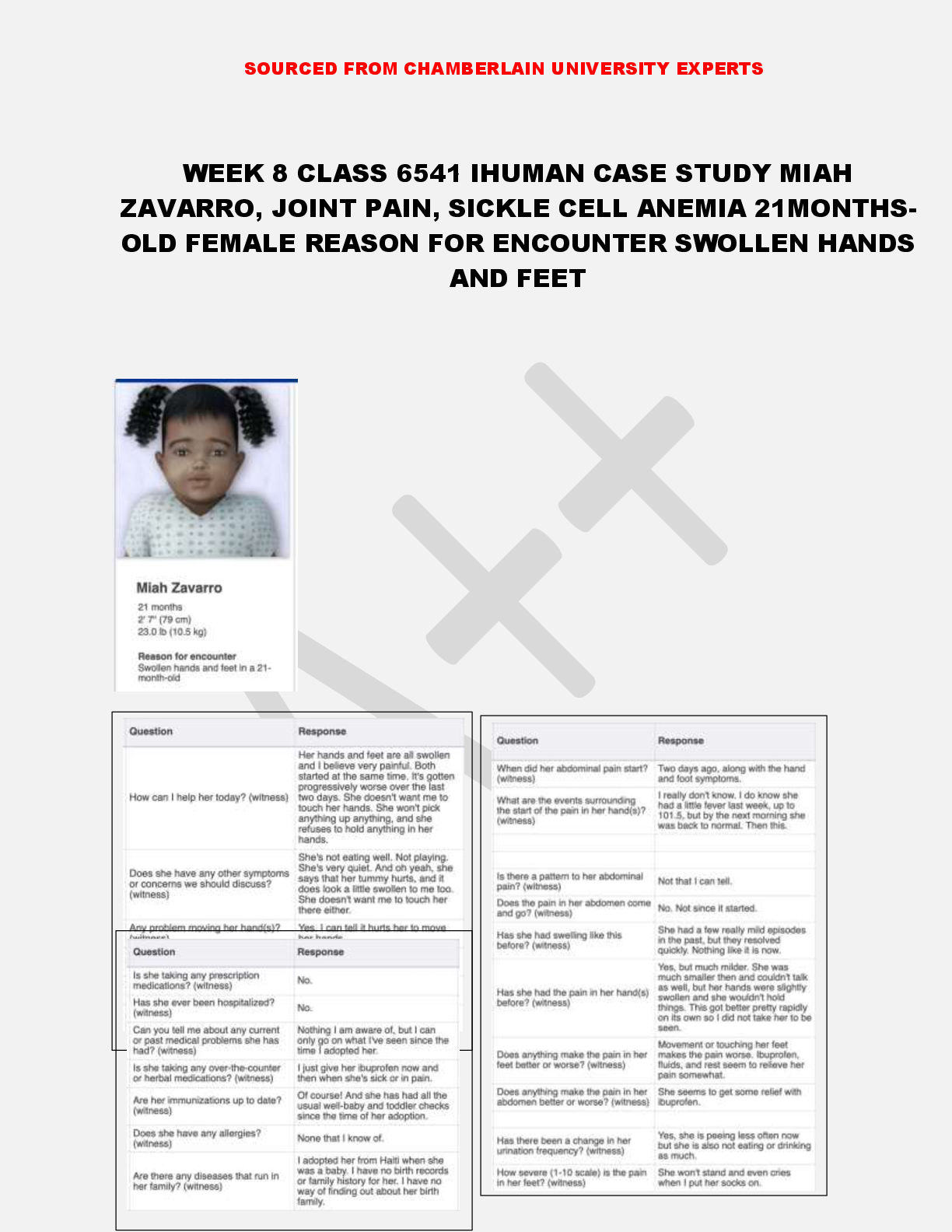*NURSING > CASE STUDY > UNFOLDING Reasoning: Sickle Cell Anemia Anthony Perkins, 15 years old (All)
UNFOLDING Reasoning: Sickle Cell Anemia Anthony Perkins, 15 years old
Document Content and Description Below
UNFOLDING Reasoning: Sickle Cell Anemia Anthony Perkins, 15 years old © 2016 Keith Rischer/www.KeithRN.com Sickle Cell Anemia Anthony Perkins, 15 years old Primary Concept Perfusion I... nterrelated Concepts (In order of emphasis) 1. Pain 2. Clotting 3. Fluid and Electrolyte Balance 4. Clinical Judgment 5. Patient Education 6. Communication© 2016 Keith Rischer/www.KeithRN.com UNFOLDING Reasoning: ANSWER KEY Sickle Cell Crisis History of Present Problem: Anthony Perkins is a 15-year-old African American male who was at a medically monitored summer camp and participated in several sports activities when the temperature was greater than 90 degrees. He began having pain in his knees and was evaluated by the camp nurse. After evaluation, he was transported to his primary care provider where he was then transferred as a direct admit to the pediatric floor of the community hospital where you are the primary nurse responsible for his care. He weighs 154 lbs or 70 kg. Personal/Social History: Anthony was diagnosed with sickle cell anemia at birth during a routine newborn screening. He was a term newborn with normal childhood illnesses. He has been hospitalized with pneumonia four times – at age 8, 9, 11, and 14. Although up to date on his usual childhood immunizations, he only recently became current with his pneumococcal and influenza vaccines. Anthony has had multiple hospitalizations for sickle cell crises and transfusions. He lives with his maternal grandmother (age 65), his maternal uncle (age 31), his half-brother (age 18), and his half-sister (age 7). His mother is absent and her whereabouts are unknown. His father has never been involved in his life. The family lives in a three-bedroom, one-bath home with all utilities. The family has an automobile; however, it is not reliable. The grandmother has never worked and is on Social Security. Anthony’s uncle works a full-time job as a delivery driver and helps support the family. The children are on Medicaid and Supplemental Nutrition Assistance Program (SNAP). What data from the histories are important and RELEVANT and have clinical significance for the nurse? RELEVANT Data from Present Problem: Clinical Significance: Anthony was attending a medically monitored summer camp. Was active in sports at camp, on a very hot day. Anthony began having knee joint pain at camp. Camp nurses are responsible for medication administration at medically monitored camps. This would indicate Anthony is compliant with his medication regime at this time. Anthony likely became dehydrated through his activities and thermal heat. This is a clinical RED FLAG that must be recognized by the nurse! Dehydration can help trigger a sickle cell crisis. Joint pain is usually one of the first signs of a sickle cell crisis, therefore this assessment finding is a clinical RED FLAG! RELEVANT Data from Social History: Clinical Significance: Diagnosed with sickle cell at birth. Only recently became current on pneumococcal and meningococcal vaccines. Anthony lives with his grandmother, uncle, and 2 half siblings. Income for the family is grandmother’s Social Security and uncle’s wages. Family automobile is unreliable. The children are on Medicaid and SNAP Management of Anthony’s disease has been recognized and available since he was an infant. History of pneumonia x 4. Hopefully, with the immunization, this will help prevent future pneumonia occurrences. Anthony has family support, although mother and father are absent. Family’s income is fixed and limited. It may be difficult for the family to keep appointments and run errands for medication, etc. Follow up with social services to see if this has been a problem in the past. With Medicaid, Anthony is able to access the health care system and resources for medical care, transportation, prescriptions, and therapies.© 2016 Keith Rischer/www.KeithRN.com With access to SNAP, Anthony and his siblings have access to healthy food choices. What is the RELATIONSHIP of your patient’s past medical history (PMH) and current meds? (Which medication treats which condition? Draw lines to connect.) PMH: Home Meds: Pharm. Classification: Expected Outcome: *Sickle cell anemia 1. Folic Acid 1 mg po daily 2. Hydroxycarbamide 200 mg po daily 1. Water-soluble B vitamin 2. Anti-neoplastic 1. Stimulates production of new red blood cells. 2. Decreases hgb sickle cells and increases fetal hgb (http://www.ncbi.nlm.nih.gov/books/NBK38503/) Sickle cell anemia>>> Folic Acid 1 mg po daily/ Hydroxycarbamide 200 mg po daily Patient Care Begins: The nurse recognizes the need to validate concern about fluid volume deficit, performs a set of orthostatic VS and obtains the following: What VS data are RELEVANT and must be recognized as clinically significant by the nurse? RELEVANT VS Data: Clinical Significance: T: 99.4 F. (37.5 C.) (oral) P: 92 BP: 102/74 Lying: HR: 92 BP: 102/74 Standing: HR: 132 BP: 92/42 Though normal, the temperature is always relevant because of the possible complication of infection/sepsis. Heart rate is elevated at rest. This could be as a result of pain, or dehydration. Remember the importance of the patho formula: CO=SVxHR. The first compensatory response by the body is to elevate HR in order to maintain adequate cardiac output. Though this BP is technically within normal range, the nurse must recognize that it is in the LOW range of normal for an adolescent who is 70 kg. Is likely confirming fluid volume deficit. Review the definition of an abnormal orthostatic BP finding. An increase in the heart rate of 20 beats or more from lying baseline to standing is by itself a POSITIVE finding and is usually seen in mild to moderate dehydration from my clinical experience. If a decrease in 20 points or more of mm/Hg in SBP is seen from lying to standing in addition to the increase in HR, this reflects moderate to severe fluid volume deficit/dehydration. Current VS: P-Q-R-S-T Pain Assessment (5th VS): T: 99.4 F. (37.5 C.) (oral) Provoking/Palliative: Movement and weight bearing/Rest, elevation, warm compresses P: 92 (regular) Quality: “My knees are really hurting…deep ache” R: 20 (regular) Region/Radiation: Bilateral knees BP: 102/74 Severity: 8/10 O2 sat: 96 Timing: Constant since around noon today Position: HR: BP: Lying 92 102/74 Standing 132 92/42© 2016 Keith Rischer/www.KeithRN.com Because he has both a drop of BP and increase in HR as well as being symptomatic, this confirms moderate to severe fluid volume depletion/dehydration. What assessment data is RELEVANT that must be recognized as clinically significant to the nurse? RELEVANT Assessment Data: Clinical Significance: Uneasy in bed, changing position frequently Increased respiratory effort, nasal flaring Pulses strong and palpable at radial/ pedal/ post-tibial landmarks Urine clear/dark amber in color No priapism present Knees swollen bilaterally; erythemic, warm to touch; decreased ROM of knees; pain reported with movement RED FLAG– patient is clearly uncomfortable and will need pain control. RED FLAG – patient is demonstrating increased work of breathing. Patient must be observed closely for worsening respiratory status. Yellow alert – this patient is susceptible to complete occlusion; current assessment is reassuring; however, pulses must be assessed completely and frequently. Dark amber color is a result of concentration of urine seen with dehydration. Priapism, defined as a sustained, painful, and unwanted erection, is a wellrecognized complication of SCD. Priapism tends to occur repeatedly. When it is prolonged, it may lead to impotence. According to one study, the mean age at which priapism occurs is 12 years, and, by age 20 years, as many as 89% of males with sickle cell disease have experienced one or more episodes of priapism. Priapism can be classified as prolonged if it lasts for more than 3 hours or as stuttering if it lasts for more than a few minutes but less than 3 hours and resolves spontaneously. Stuttering episodes may recur or develop into more prolonged events (Maakaron, J.E. & Taher, A.T. 2015). RED FLAG – assessment reflects inflammatory response and vasoocclusion; this must be monitored very closely for complete occlusion; patient must be treated for this very painful condition; complications could include complete occlusion and bone necrosis. Current Assessment: GENERAL APPEARANCE: Uneasy in bed, changing position frequently, cooperative and responds to questions appropriately. RESP: Breath sounds clear with equal aeration bilaterally, increased respiratory effort; mild nasal flaring noted; no tracheal tugging, no retractions. CARDIAC: Pink, warm and dry, no edema, heart sounds regular with no abnormal beats, no murmur noted, pulses strong, equal with palpation at radial/pedal/post-tibial landmarks, denies chest pain. NEURO: Alert and oriented to person, place, time, and situation (x4). GI: Abdomen soft/nontender, bowel sounds audible per auscultation in all four quadrants. GU: Voiding without difficulty, urine clear/dark amber in color, no priaprism present. SKIN: Skin integrity intact. MUSKULOSKELETAL: Knees swollen bilaterally, erythemic, warm to touch, decreased ROM of knees, pain reported with movement.© 2016 Keith Rischer/www.KeithRN.com Lab Results: What lab results are RELEVANT and must be recognized as clinically significant by the nurse? What lab results are RELEVANT and must be recognized as clinically significant by the nurse? RELEVANT Lab(s): Clinical Significance: TREND: Improve/Worsening/Stable: WBC 10.5 Neutrophil %: 55 Hgb 9.8 Hct 28.5 Retic 2.6 IRF 30.8 Not significantly elevated therefore presence of infection is likely low. Continue to TREND closely First responder to infection/inflammation. Though normal it is confirming absence of systemic response to infection or inflammation. Decreased ability for RBCs to carry oxygen. Due to sickle cell anemia this is EXPECTED Decreased volume of RBCs in the blood available for circulation. Due to sickle cell anemia this is EXPECTED Bone marrow is attempting to produce more RBCs. In an effort to produce more RBCs, bone marrow is sending out immature cells. No concerning trends of labs. Acceptable ambiguity is present. RELEVANT Lab(s): Clinical Significance: TREND: Improve/Worsening/Stable: Creatinine 1.5 BUN 38 GOLD standard to assess renal function. Creatinine elevation could be due to volume depletion/dehydration or could represent kidney damage as a complication of sickle cell crisis. Will need further evaluation. Monitor closely and TREND over the next 24-48 hours. Though not as specific as creatinine to assess renal function, it does elevate in acute renal failure as well as dehydration. Monitor closely and TREND over the next 24-48 hours. Worsening Worsening Complete Blood Count (CBC:) Current: High/Low/WNL? Previous: WBC (4.5–11.0 mm 3) 10.5 WNL 9.5 Hgb (12–16 g/dL) 9.8 Low 10.2 Hct (36.0 – 46.0%) 28.5 Low 30.2 Platelets (150-450 x103/µl) 385 WNL 425 Neutrophil % (42–72) 55 WNL 65 Band forms (3–5%) -0- WNL 0 Retic (0.5 – 1.5%) 2.6 High 1.4 IRF (9.0 – 18.7%) (Immature reticulocyte fraction) 30.8 High 22.8 Basic Metabolic Panel (BMP:) Current: High/Low/WNL? Previous: Sodium (135–145 mEq/L) 139 WNL 143 Potassium (3.5–5.0 mEq/L) 4.2 WNL 4.5 Glucose (70–110 mg/dL) 106 WNL 95 BUN (7–25 mg/dl) 38 High 6 Creatinine (0.6–1.2 mg/dL) 1.5 High 0.5© 2016 Keith Rischer/www.KeithRN.com RELEVANT Lab(s): Clinical Significance: TREND: Improve/Worsening/Stable: Specific Gravity 1.038 Protein Trace Ketones Trace Bilirubin 1+ Urine is concentrated, Supportive of dehydration diagnosis This is a yellow flag – warrants watching but not alarming. Could be due to exercising at camp. Ketones are a byproduct of fat breakdown. This is a yellow flag - warrants watching. This could be due to inadequate calorie intake during exercise. Bilirubin would be expected in a sickle cell patient due to the rapid breakdown of RBCs. This is a yellow flag and warrants watching. Urine specific gravity, protein, and ketones have normalized due to the hydration. The bilirubin is likely a chronic condition due to the breakdown of RBCs seen in sickle cell anemia. Lab Planning: Creating a Plan of Care with a PRIORITY Lab: Lab: Normal Value: Clinical Significance: Nursing Assessments/Interventions Required: Creatinine Value: 1.5 Normal Value: 0.5-1.2 mg/dl Critical value: >1.5 *End product of creatine metabolism, which is performed in skeletal muscle *Gold standard for kidney function because creatinine is produced in consistent quantity and rate of clearance reflects glomerular filtration *Assess I&O closely *Daily weights *Fluid restriction if ordered *Assess for signs of fluid retention/edema Van Leeuwen, A. & Poelhuis-Leth, D.J. (2009) Clinical Reasoning Begins… 1. What is the primary problem that your patient is most likely presenting with? Sickle cell crisis 2. What is the underlying cause/pathophysiology of this concern? The abnormal cells (Hgb S) are sickle shaped, leading to vaso-occlusion and pain. This condition is often precipitated by dehydration. Repeated and prolonged sickling involves the membrane; the RBC assumes the characteristic sickled shape. After recurrent episodes of sickling, membrane damage occurs and the cells are no longer capable of resuming the biconcave shape upon reoxygenation. Thus, they become irreversibly sickled cells. From 5-50% of RBCs permanently remain in the sickled shape. Sickle RBCs adhere to endothelium because of increased stickiness (Maakaron & Taher, 2015). Urine Analysis (UA:) Current: WNL/Abnormal? Previous: Color (yellow) Yellow WNL Yellow Clarity (clear) Clear WNL Clear Specific Gravity (1.015-1.030) 1.038 Abnormal 1.010 Protein (neg) Trace Abnormal Neg Glucose (neg) Neg WNL Neg Ketones (neg) Trace Abnormal Neg Bilirubin (neg) 1+ Abnormal 1+ Blood (neg) Neg WNL Neg Nitrite (neg) Neg WNL Neg LET (Leukocyte Esterase) (neg) Neg WNL Neg© 2016 Keith Rischer/www.KeithRN.com Collaborative Care: Medical Management Care Provider Orders: Rationale: Expected Outcome: Morphine patient controlled analgesia (PCA) 1 mg continuous, PCA dose 1 mg every 10 minutes Initiate IV fluid therapy of D5 ½ NS with 20 MEq KCL @ 120 ml/hr Complete blood count (CBC) Reticulocyte count Basic metabolic panel (BMP) Urine analysis (UA) Apply Oxygen, 2 liters per minute (LPM) via nasal cannula (NC) Sickle cell patients require opioids for the severe pain that is a result of crises. PCA administration allows the patient to control pain quickly with no need to wait for the nurse to administer. Hydration will help prevent vaso-occlusion of the sickled cells. Will also help transport normal hgb/ oxygen to the organs. Establish current hematologic status Establish current hematologic status Establish baseline metabolic function. Evaluate renal function Establish baseline renal function Increase available O2 for oxygenation Decreased pain. Decreased vaso-occlusion, decreased pain, increased oxygenation. Likely reveal anemia. Rule out metabolic imbalance. Establish renal function. Decreased work of breathing, increased oxygen saturation. No change from baseline Decreased work of breathing, increased oxygen saturation PRIORITY Setting: Which Orders Do You Implement First and Why? Care Provider Orders: Order of Priority: Rationale: Morphine patient controlled analgesia (PCA) 1 mg continuous, PCA dose 1 mg every 10 minutes Initiate IV fluid therapy of D5 ½ NS with 20 MEq KCL @ 120 ml/hr Apply O2, 2 LPM, via nasal cannula (NC) 1. Initiate IV fluid therapy of D5 ½ NS with 20 MEq KCL @ 120 ml/hr 2. Morphine patient controlled analgesia (PCA) 1 mg continuous, PCA dose 1 mg every 10 minutes 3. Apply O2, 2LPM, via NC 1. IV access must be initiated immediately to begin rehydration. Is also a circulatory or “C” priority. IV access is also essential to pain control. 2. Pain control is a very high priority for sickle cell patients. Pain control will help decreased O2 demands, as well. 3. Although supplemental O2 is not considered beneficial, it is often performed in clinical practice. If oxygen saturation is >95% has ? benefit, therefore it is not a true “B” or breathing priority. Medication Dosage Calculation: Medication/Dose: Mechanism of Action: Volume/time frame to Safely Administer: Nursing Assessment/Considerations: Ketorolac 30 mg IV push every 6 hours Inhibits prostaglandin synthesis, producing analgesia. Also has antipyretic and antiinflammatory effects. 30 mg/1 mL vial Volume/time frame: 0.5 mL every 15 seconds Use for short-term management of pain <5 days Onsets in 10 minutes, peak effect in 1-2 hours, lasts 6 hours. Use this knowledge to reassess pain in 60-90 minutes after administration Minimal side effects, can cause bleeding. Contraindicated with renal disease. Is an injectable NSAID© 2016 Keith Rischer/www.KeithRN.com 3. What nursing priority(s) will guide your plan of care? (if more than one-list in order of PRIORITY) C (circulatory priority): Ineffective tissue perfusion C (circulatory priority): Fluid volume deficit Acute pain/control of pain In the care plan below, encourage your students to see the relationship between these three priorities and how by addressing the “C” priorities of fluid volume deficit, it will also influence tissue perfusion and even help decrease pain as hydration is improved. 4. What interventions will you initiate based on this priority? Nursing Interventions: Rationale: Expected Outcome: Establish peripheral IV and administer IV fluids and pain medications Apply warm compresses to knees. Dehydration can precipitate pain, since acidosis results in a shift of the oxygen dissociation curve, causing hemoglobin to desaturate more readily. Hemoconcentration also is a common mechanism. Warm compresses help with pain and vasodilate vessels to prevent occlusion. Improved oxygenation to cells Decreased pain Decreased pain and vaso-occlusion through vasodilation Additional Nursing Interventions: Assist patient to adjust bed position to position of comfort. Position of comfort is very individualized. Comfortable position will lead to decreased pain and decreased oxygen demands. 5. What body system(s) will you most thoroughly assess based on the primary/priority concern? Circulatory system, respiratory system 6. What is the worst possible/most likely complication to anticipate? Acute chest syndrome (pulmonary embolus) is leading cause of death in adults. Complete vaso-occlusion of vessels- peripheral circulation may be impacted as well as organ perfusion–including peripheral and cerebral arteries that can cause a CVA. Infection/sepsis o Life-threatening bacterial infections are a major cause of morbidity and mortality. Recurrent vasoocclusion induces splenic infarctions and consequent autosplenectomy, predisposing to severe infections with encapsulated organisms (eg, Haemophilus influenzae, Streptococcus pneumoniae) (Maakaron & Taher, 2015). 7. What nursing assessment(s) will you need to initiate to identify this complication if it develops? Oxygenation status must also be closely monitored (RR, O2 sat) Pedal, post-tibial pulses must be assessed frequently to assure complete vaso-occlusion does not occur. Baseline neuro assessment to assess for any neuro changes 8. What nursing interventions will you initiate if this complication develops? Any of the most likely complications require EARLY recognition and prompt notification of the primary care provider so the nurse must know who to contact. For any impaired oxygenation concerns be prepared to administer oxygen to maintain O2 sat >92% and raise the HOB. 9. What psychosocial needs will this patient and/or family likely have that will need to be addressed? Emotional support Knowledge and education about what is taking place and what the care priorities will be in the days ahead© 2016 Keith Rischer/www.KeithRN.com 10. How can the nurse address these psychosocial needs? Emotional support o BE PRESENT and AVAILABLE. See the section on caring at the end of this case study for more information. Knowledge and education about what is taking place and what the care priorities will be in the days ahead o The nurse can integrate patient/family education naturally while providing care by simply explaining at their level everything that the nurse/physician has ordered and WHY it needs to be done. This is why it is essential for the nurse to know and DEEPLY understand the rationale for both the physician and nursing plan of care; so it can be readily taught and explained to the patient/family at a level they can understand. Evaluation: Evaluate the response of your patient to nursing and medical interventions during your shift. All physician orders have been implemented that are listed under medical management. Two hours later… 1. What clinical data is RELEVANT and must be recognized as clinically significant? RELEVANT VS Data: Clinical Significance: HR now 72 RR now 14 HR has decreased – likely due to hydration and pain control. RR has decreased – likely due to pain control and less oxygen demand from the body (patient is resting now) RELEVANT Assessment Data: Clinical Significance: Patient is more restful in the bed now. No nasal flaring. Hydration and pain control are effective. Oxygen demands have decreased, resulting in decreased work of breathing. This, coupled with hydration and pain control have improved patient’s respiratory status. Current VS: Most Recent: Current PQRST: T: 99.0 (37.2 C) (oral) 99.4 (37.5 C) (oral) Provoking/Palliative: Movement and weight bearing/Rest, elevation, warm compresses P: 72 (regular) 92 (regular) Quality: “My knee pain is a little better, still ache” R: 14 (regular) 20 (regular) Region/Radiation: Bilateral knees BP: 112/68 112/74 Severity: 4/10 O2 sat: 97% RA 96% RA Timing: Constant since around noon today Current Assessment: GENERAL APPEARANCE: Resting quietly in bed. Cooperative and responds to questions appropriately. RESP: Breath sounds clear with equal aeration bilaterally; nasal flaring has ceased; no tracheal tugging, no retractions. CARDIAC: Pink, warm and dry, no edema, heart sounds regular with no abnormal beats, no murmur noted, pulses strong, equal with palpation at radial/pedal/post-tibial landmarks; denies chest pain. NEURO: Alert and oriented to person, place, time, and situation (x4) GI: Abdomen soft/nontender, bowel sounds audible per auscultation in all four quadrants. GU: Voiding without difficulty, urine clear/yellow; no priaprism. SKIN: Skin integrity intact MUSKULOSKELETAL: Knees swollen bilaterally; erythemic, warm to touch; decreased ROM of knees; pain reported with movement.© 2016 Keith Rischer/www.KeithRN.com 2. Has the status improved or not as expected to this point? Status has improved. Work of breathing has decreased. Patient is more comfortable. Vital signs are reassuring and trending in the right direction. 3. Does your nursing priority or plan of care need to be modified in any way after this evaluation assessment? No. Nurse must continue to closely monitor current situation and care. Fluids, pain control and monitoring of renal function must be vigilant. 4. Based on your current evaluation, what are your nursing priorities and plan of care? Priorities remain hydration and correcting fluid volume deficit, pain control, and monitoring of I/O (monitor renal function). It is now the end of your shift. Effective and concise handoffs are essential to excellent care and if not done well, can adversely affect this patient’s care. You have done an excellent job to this point, now finish strong and give the following SBAR report to the nurse who will care for this patient: Situation: Name/age: Anthony Perkins is a 15-year-old male BRIEF summary of primary problem: He was at a medically monitored summer camp and participated in several sports activities when the temperature was greater than 90 degrees. He began having pain in his knees and was evaluated by the camp nurse. Background: Primary problem/diagnosis: Increased pain/sickle cell crisis RELEVANT past medical history: Anthony was diagnosed with sickle cell anemia as a newborn (Newborn screening and Sickledex); he has had multiple hospitalizations for transfusions and treatments of crises Assessment: Most recent vital signs: T: 99.0 (37.2 C) (oral) P: 72 (regular) R: 14 (regular) BP: 112/68 O2 sat: 97% RA RELEVANT body system nursing assessment data: GENERAL APPEARANCE: Resting quietly in bed. Cooperative and responds to questions appropriately. MUSKULOSKELETAL: Knees swollen bilaterally; erythemic, warm to touch; decreased ROM of knees; pain reported with movement. Current PQRST: Provoking/Palliative: Movement and weight bearing/Rest, elevation, warm compresses Quality: “My knee pain is a little better, still ache” Region/Radiation: Bilateral knees Severity: 4/10 Timing: Constant since around noon today© 2016 Keith Rischer/www.KeithRN.com Education Priorities/Discharge Planning 1. What will be the most important discharge/education priorities you will reinforce with his medical condition to prevent future readmission with the same problem? Pacing activities and maintaining hydration are paramount education priorities with Anthony. Anthony is very familiar with his condition. However, it is likely he became engrossed in an activity, did not drink enough fluids, and became dehydrated. Nursing staff should stress to Anthony that he must be aware of his condition at all times. He should be supported in being a self-advocate, as well. He is coming into adulthood and he needs to be empowered to advocate for his care. In this instance, he could have advocated for a break or more fluids. 2. What are some practical ways you as the nurse can assess the effectiveness of your teaching with this patient? Anthony should be able to verbalize understanding of the teaching. The nurse can also perform role playing exercises in order to give Anthony experience at advocating for his care and needs. This will empower Anthony to be the advocate he will need to become as an adult. Caring and the “Art” of Nursing 1. What is the patient likely experiencing/feeling right now in this situation? Anthony is likely very disappointed that he is missing out on his camp experience. Peers and peer relationships are very important to adolescents. It is likely Anthony is worried about what his friends think/feel about his health condition and need to leave camp for treatment. He may be embarrassed that he had to leave camp. 2. What can you do to engage yourself with this patient’s experience, and show that he matters to you as a person? Anthony must be given time to rest and recover from the initial pain of the crisis before intervention begins. If he is in a great deal of pain, he will not be receptive to sharing and opening up to the nurse. It is sometimes difficult for teens to imagine adults as teens. If the nurse had experienced a similar instance of embarrassment or disappointment as a teen, it may be helpful to share this with Anthony. The nurse should be a non-judgmental ear and be willing to listen to Anthony when he feels able to share his feelings. RELEVANT lab values: Hgb: 9.8 IRF: 30.8 Creatinine: 1.5 UA: sp. gr: 1.038 Protein: trace Ketones: trace How have you advanced the plan of care? IV established IV fluids initiated to rehydrate Ketorolac given for pain Patient response: Pain has decreased with ketorolac INTERPRETATION of current clinical status (stable/unstable/worsening): Stable, gradually improving Recommendation: Suggestions to advance plan of care: Continue hydration and pain control with morphine PCA. Warm compresses have been helpful for knee pain, as well. Follow creatinine and BUN closely.© 2016 Keith Rischer/www.KeithRN.com Nursing staff should also encourage Anthony to keep in touch with peers and family members through visits as tolerated. If this is not possible (transportation issues, etc.), then perhaps Facebook, Twitter, or FaceTime would be options to help Anthony. Use Reflection to THINK Like a Nurse Reflection-IN-action (Tanner, 2006) is the nurse’s ability to accurately interpret the patient’s response to an intervention in the moment as the events are unfolding to make a correct clinical judgment. 1. What did I learn from this scenario? Have students share and reflect 2. How can I use what has been learned from this scenario to improve patient care in the future? Have students share and reflect Author Kimberly Hill, DNP, RN, Assistant Professor, University of Arkansas at Little Rock Reviewers Linden Fraser, RN, MSN, Nursing Faculty, Nicolet College, Rhinelander, Wisconsin References Maakaron, J.E. & Taher, A.T. (2015). Sickle Cell Anemia. Retrieved from http://emedicine.medscape.com/article/205926-overview#a4 [Show More]
Last updated: 2 years ago
Preview 1 out of 12 pages
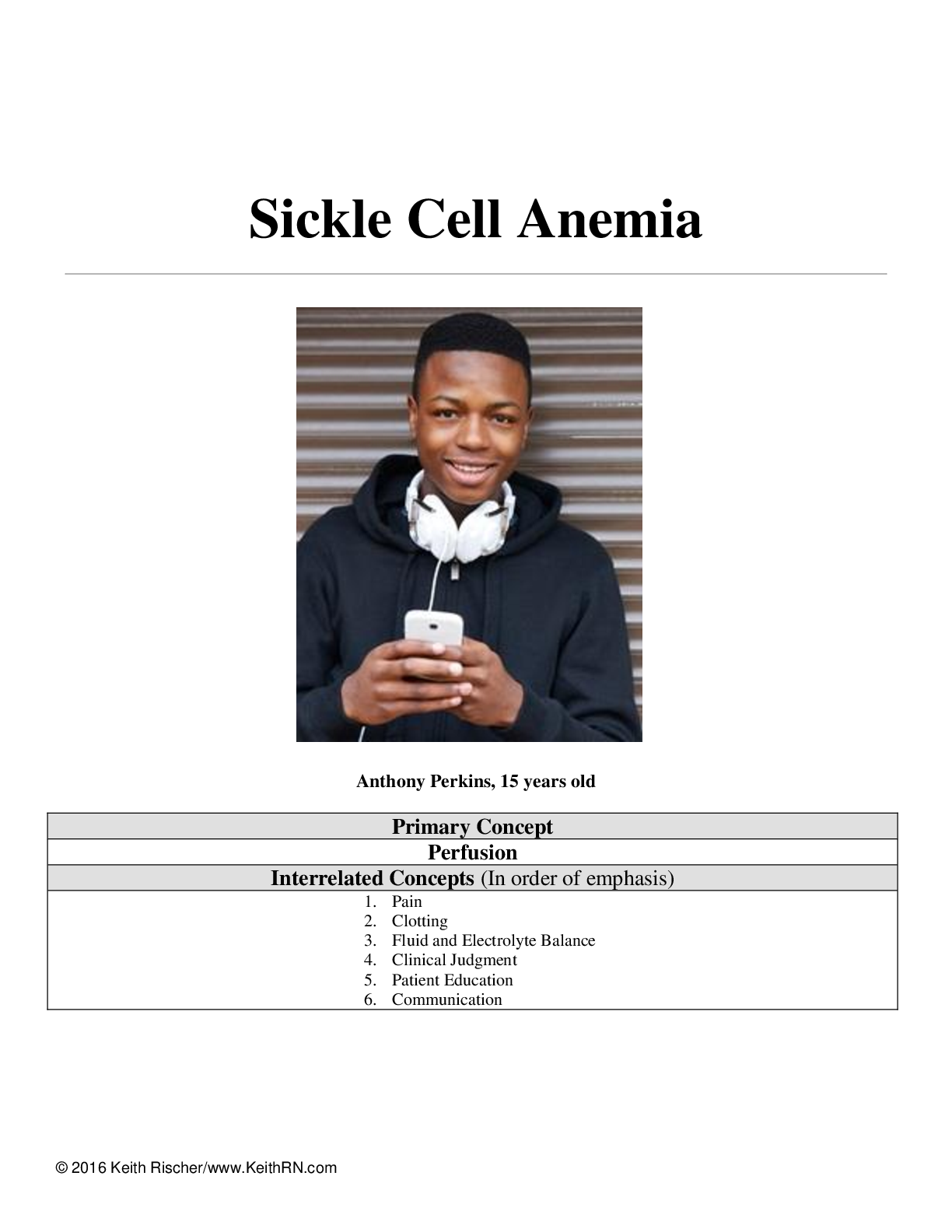
Buy this document to get the full access instantly
Instant Download Access after purchase
Buy NowInstant download
We Accept:

Reviews( 0 )
$9.00
Can't find what you want? Try our AI powered Search
Document information
Connected school, study & course
About the document
Uploaded On
Nov 22, 2022
Number of pages
12
Written in
Additional information
This document has been written for:
Uploaded
Nov 22, 2022
Downloads
0
Views
92

.png)
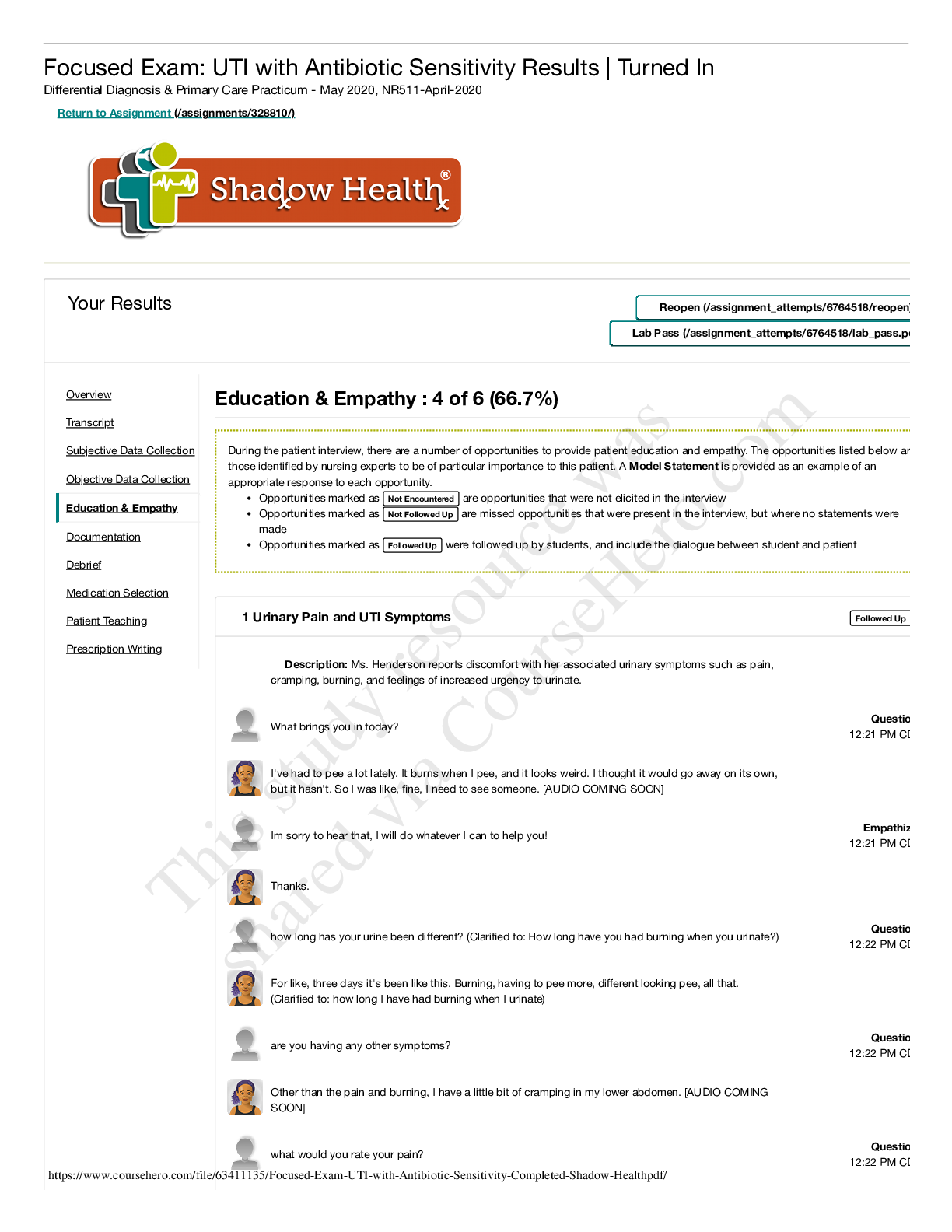
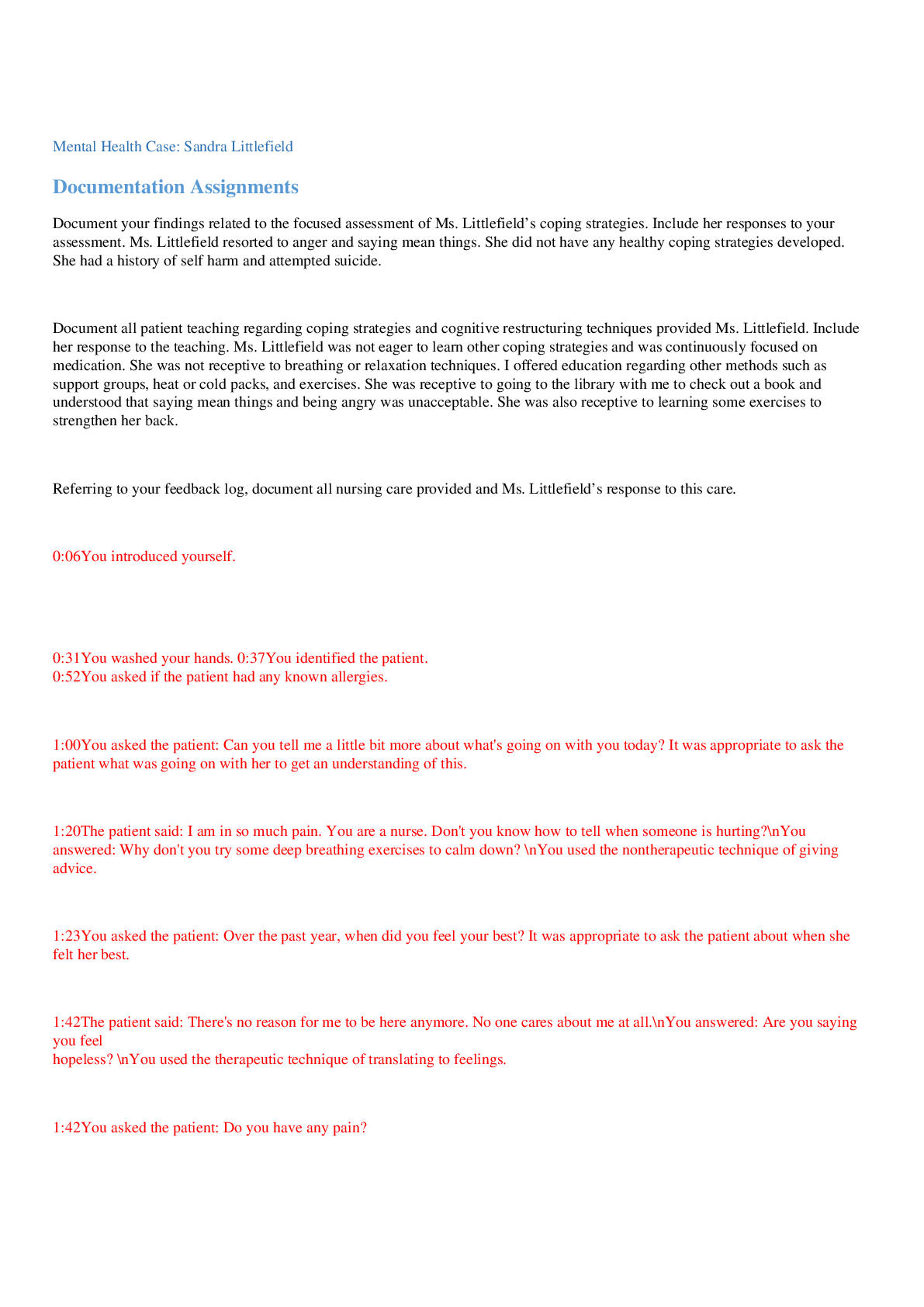
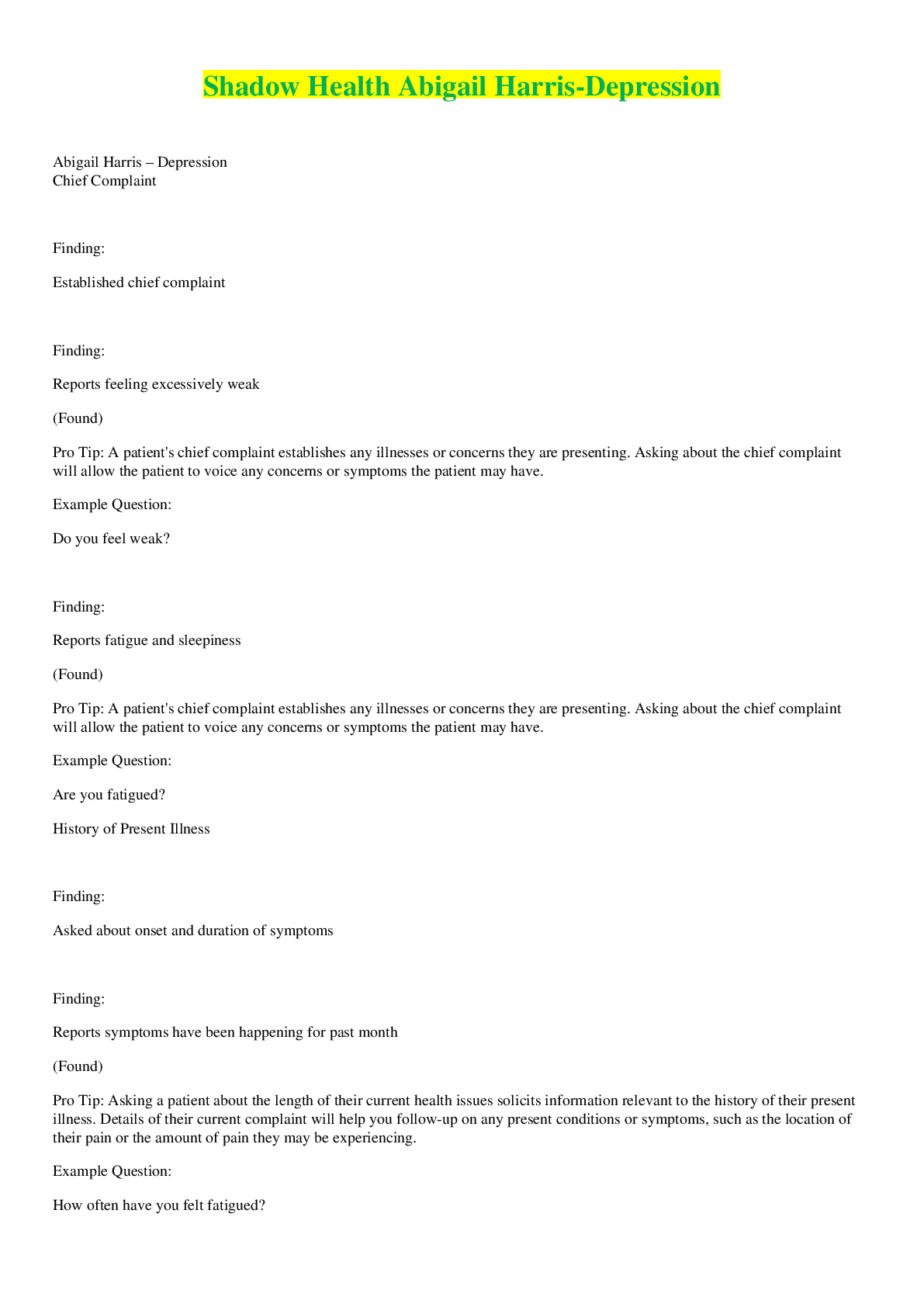



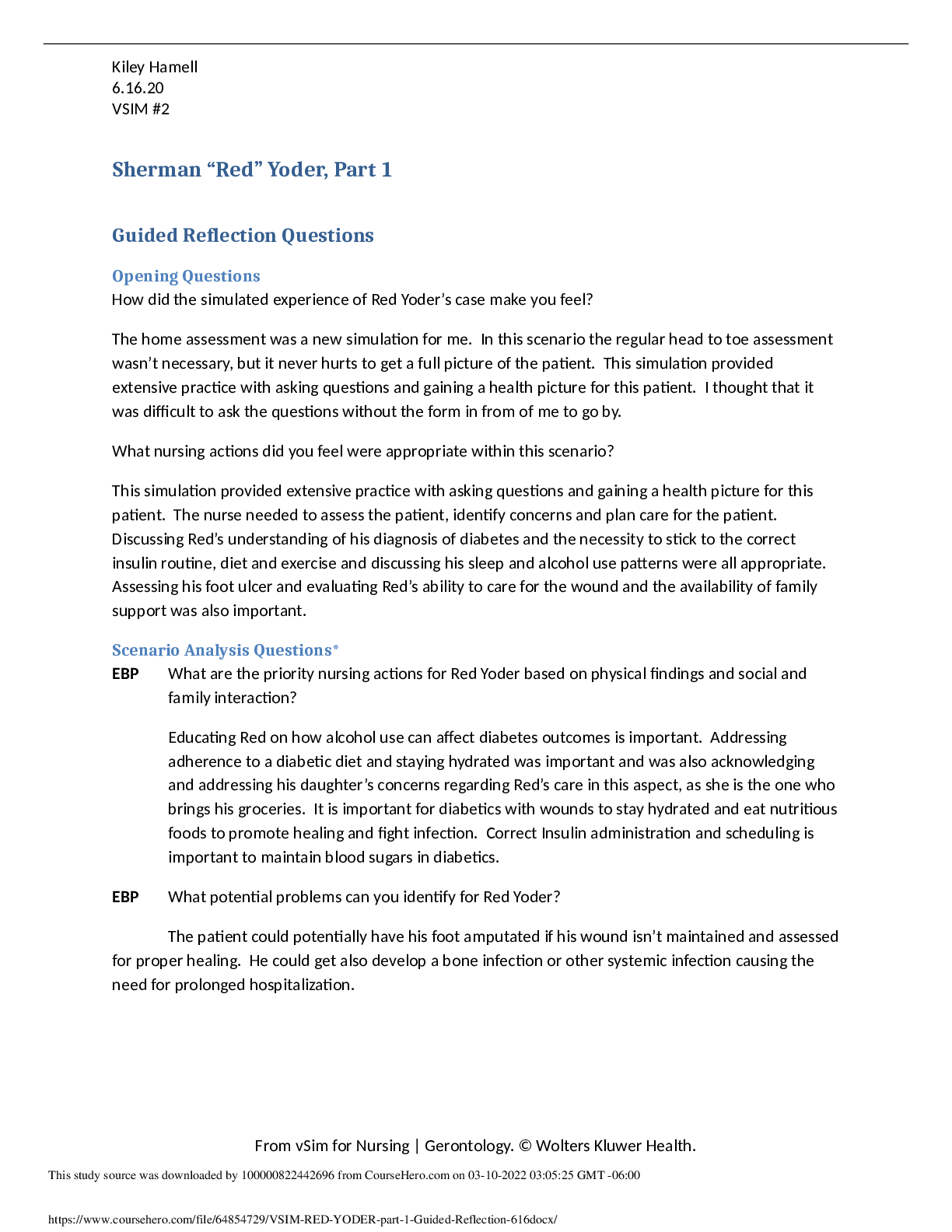


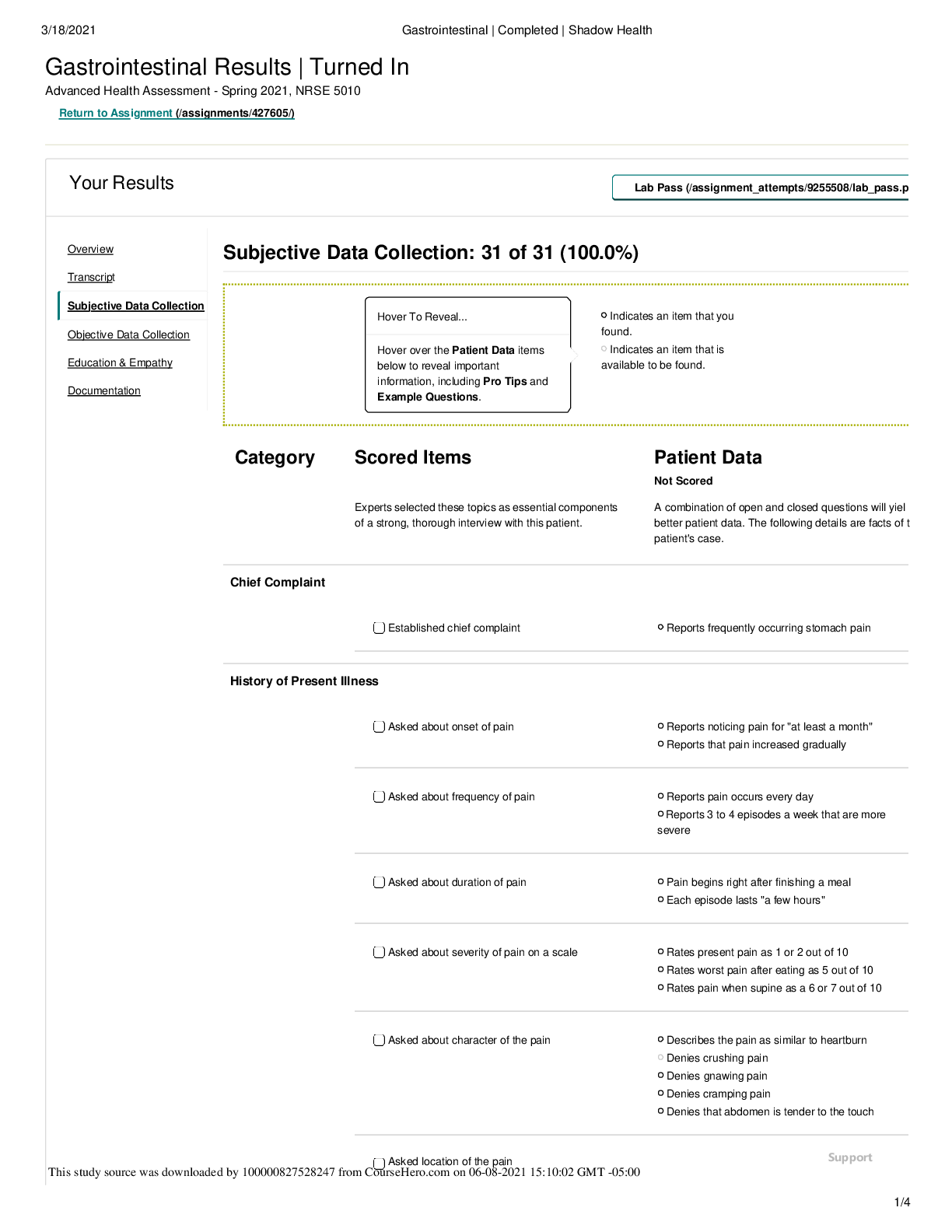

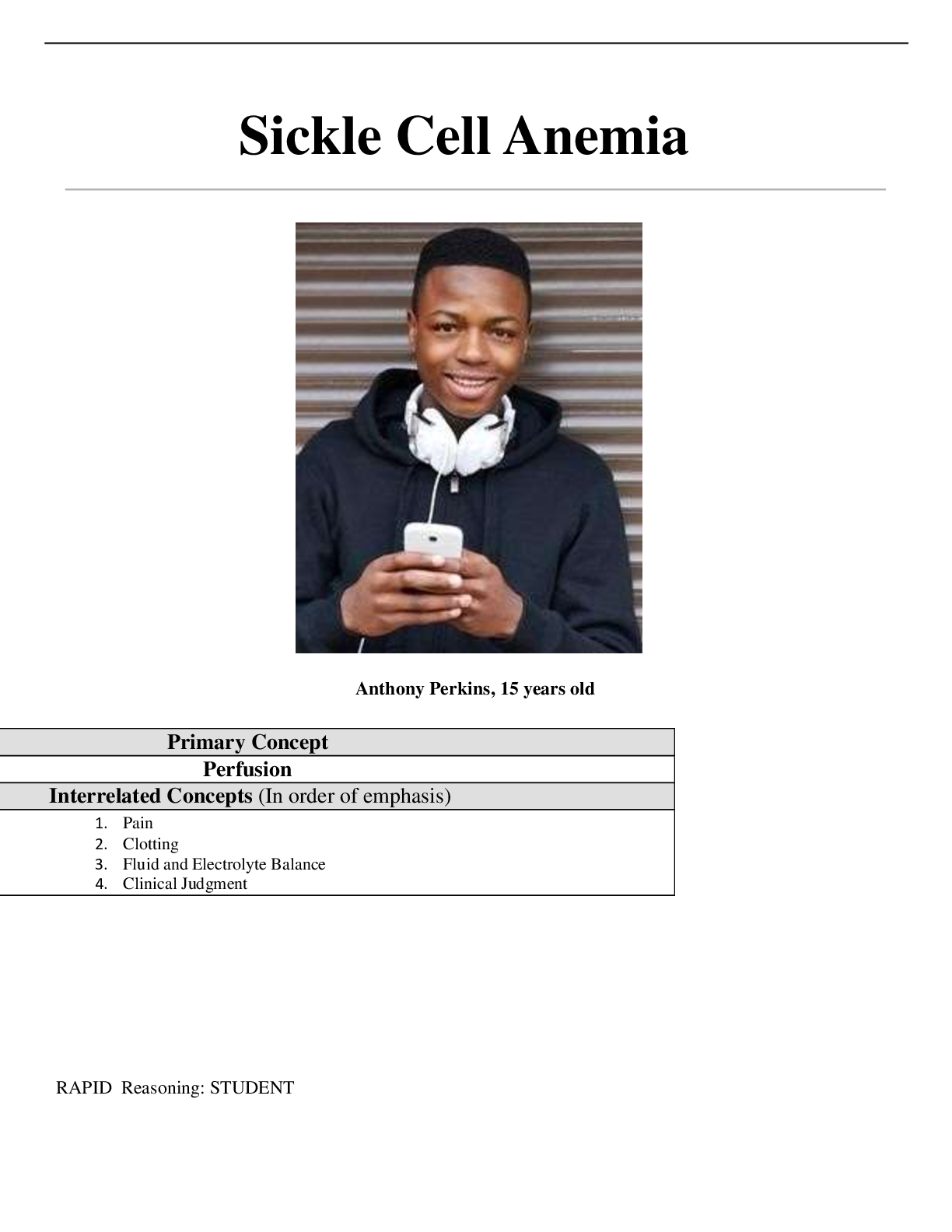
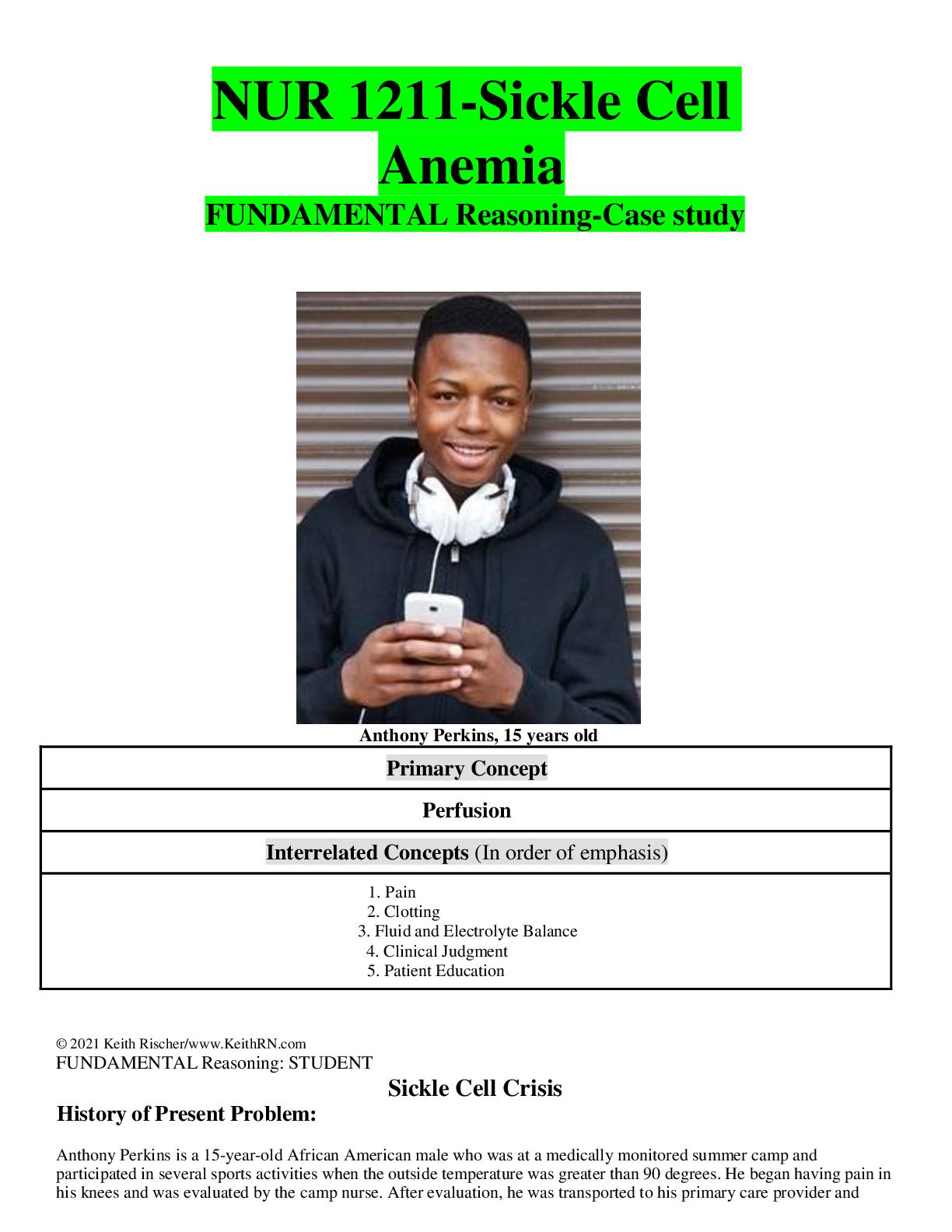


 (1).png)
.png)

